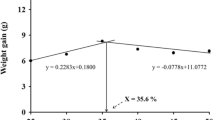Abstract
A 120-day feeding trial was designed to determine the effects of different dietary protein and lipid levels and protein to energy ratio (P:E) on growth performance and feed utilization of hatchery-reared juvenile spotted babylon, Babylonia areolata, cultured under a flow-through seawater system. Six diets were formulated to contain three protein levels (18, 28, and 36%) and two lipid levels (10 and 15%) in a 3 × 2 factorial design with three replicates to provide six different dietary P:E ratios (50.17, 49.09, 68.50, 65.85, 88.66, and 85.36 mg protein/kcal). Each replicate was stocked with 50 snails (0.12 + 0.01 g, initial weight) and fed to satiation once daily. The results showed that survival was above 96% at the end of the feeding trial in all groups and was not affected by either dietary protein level or dietary lipid level. The highest significant (P < 0.05) growth and feed utilization were observed for juveniles fed diet with a P:E ratio of 88.66 kcal g−1 diet. With respect to dietary protein and lipid levels, the highest (P < 0.05) values for growth and feed efficiency were observed for snails fed a diet containing 36% protein level and the same trend was observed for snails fed a diet with 10% lipid level. This results indicated that the diet containing 36% protein and 10% lipid level with a dietary P:E ratio of 88.66 mg protein/kcal would be suitable for optimum growth and feed utilization of B. areolata juveniles.
Similar content being viewed by others
References
AOAC (1990) Official methods of analysis, 15th edn. Association of Official Analytical Chemists, Arington, p 1298
Britz P (1996) Effect of dietary protein level on growth performance of South Africa abalone, Haliotis midae, fed fishmeal-based semi-purified diets. Aquaculture 140:55–61
Chaitanawisuti N, Kritsanapuntu A (1999) Growth and production of hatchery-reared juvenile spotted babylon, Babylonia areolata Link 1807, cultured to marketable sizes in intensive flow-through and semi-closed recirculating water system. J Aquac Res 31:415–419
Chaitanawisuti N, Kritsanapuntu S, Natsukari Y (2002) Economic analysis of a pilot commercial production for spotted babylon Babylonia areolata Link, 1807 marketable sizes using a flow-through culture system in Thailand. Aquacult Res 33:1265–1272
Chen Y, Ke CH, Zhou SQ, Li FX (2005) Effects of food availability on feeding and growth of cultivated juvenile Babylonia formosae habei (Altena & Gittenberger 1981). Aquacult Res 36:94–99
Daniels WH, Robinson EH (1986) Protein and energy requirements of juvenile red drum Sciaenops ocellatus. Aquaculture 53:243–252
Hewitt DR (1992) Response of protein turnover in the brown tiger prawn Penaeus esculentus to variation in dietary protein content. Comp Biochem Physiol 103:183–187
Lee SM, Kim KD (2001) Effects of dietary protein and energy levels on the growth, protein utilization and body composition of juvenile masu salmon (Oncorhynchus masou Brevoort). Aquacult Res 32:39–45
Lee SM, Lim TJ (2005) Effects of dietary protein and energy levels on growth and lipids composition of juvenile snail (Semisulcospira gottschei). J Shellfish Res 24:99–102
Lopez LM, Torres AL, Durazo E, Drawbridge M, Bureau DP (2006) Effects of lipid on growth and feed utilization of white sea bass (Atractoscion nobilis) fingerlings. Aquaculture 253:557–563
Mai K, Mercer JP, Donlon J (1995a) Comparative studies on the nutrition of two species of abalone, Haliotis tuberculata L. and Haliotis discus hannai Ino. III. Response of abalone to various levels of dietary lipids. Aquaculture 134:65–80
Mai K, Mercer JP, Donlon J (1995b) Comparative studies on the nutrition of two species of abalone, Haliotis tuberculata L. and Haliotis discus hannai Ino. IV. Optimum dietary protein level for growth. Aquaculture 136:165–180
Zhou JB, Zhou QC, Chi SY, Yang QH, Lui CW (2007a) Optimal dietary protein requirement for juvenile ivory shell, Babylonia areolata. Aquaculture 270:186–192
Zhou JB, Zhou QC, Chi SY, Yang QH, Lui CW (2007b) Effect of dietary lipid level on growth performance, feed utilization and digestive enzyme for juvenile ivory shell, Babylonia areolata. Aquaculture 272:535–540
Acknowledgments
This study was supported by the National Research Council of Thailand (NRCT), who provided fund for this research in the fiscal year 1996–2007. We are especially grateful to Associated Professor Dr. Somkiat Piyatiratitivorakul, Faculty of Science, Chulalongkorn University for his encouragement and critical reading of the article.
Author information
Authors and Affiliations
Corresponding author
Rights and permissions
About this article
Cite this article
Chaitanawisuti, N., Kritsanapuntu, S. & Santaweesuk, W. Effects of dietary protein and lipid levels and protein to energy ratios on growth performance and feed utilization of hatchery-reared juvenile spotted babylon (Babylonia areolata). Aquacult Int 19, 13–21 (2011). https://doi.org/10.1007/s10499-010-9337-4
Received:
Accepted:
Published:
Issue Date:
DOI: https://doi.org/10.1007/s10499-010-9337-4




